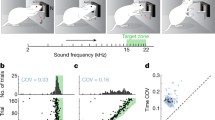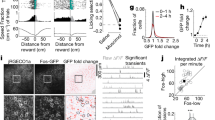Abstract
Fos levels were measured in rats trained in one of two qualitatively different spatial memory tasks in a water maze. In one task, (landmark condition) rats found a submerged platform that was always 25 cm south of a visible landmark, the absolute position of the platform and landmark changing after every trial. In the other task (place condition), rats swam to a platform that remained in the same absolute position on every session, but changed session to session, with this task relying on the memory of allocentric cues. Despite matched swim times, the landmark condition resulted in higher levels of Fos in a wide range of cortical and subcortical sites, including the hippocampus and its connections. Structural equation modelling revealed two different patterns of hippocampal function. In the allocentric place task there was a significant association between Fos activity in the entorhinal cortices and the hippocampus proper, while in the non-allocentric landmark task this relationship was not present, but was replaced by a connection from the entorhinal cortices to the subiculum. Thus, the two different tasks engage two different modes of hippocampal activity as demonstrated by Fos expression.












Similar content being viewed by others
References
Aggleton JP, Vann SD, Oswald CJP, Good M (2000) Identifying cortical inputs to the rat hippocampus that subserve allocentric spatial processes: a simple problem with a complex answer. Hippocampus 10:466–474
Amaral DG, Witter MP (1995) Hippocampal formation. In: Paxinos G (ed) The rat nervous system, 2nd edn. Academic, New York, pp 443–493
Bollen KA, Long JS (1992) Tests for structural equation models: introduction. Sociol Method Res 21:123–131
Burwell RD, Amaral GD (1998) Cortical afferents of the perirhinal, postrhinal, and entorhinal cortices of the rat. J Comp Neurol 398:179–205
Burwell RD, Witter MP, Amaral DG (1995) Perirhinal and postrhinal cortices of the rat: a review of the neuroanatomical literature and comparison with findings from the monkey brain. Hippocampus 5:396–408
Collett TS, Cartwright BA, Smith BA (1986) Landmark learning and visuospatial memory in gerbils. J Comp Physiol [A] 158:835–851
Commins S, Aggleton JP, O'Mara SM (2002) Physiological evidence for a possible projection from dorsal subiculum to hippocampal area CA1. Exp Brain Res 146:155–160
Dragunow M, Faull R (1989) The use of c-fos as a metabolic marker in neuronal pathway tracing. J Neurosci Methods 29:261–265
Galani R, Jarrard LE, Will BE, Kelche C (1997) Effects of postoperative housing conditions on functional recovery in rats with lesions of the hippocampus, subiculum, or entorhinal cortex. Neurobiol Learn Mem 67:43–56
Galani R, Weiss I, Cassel JC, Kelche C (1998) Spatial memory, habituation, and reactions to spatial and nonspatial changes in the rats with selective lesions of the hippocampus, the entorhinal cortex or the subiculum. Behav Brain Res 96:1–12
Gall CM, Hess US, Lynch G (1998) Mapping brain networks engaged by, and changed by, learning. Neurobiol Learn Mem 70:14–36
Glasier MM, Sutton RL, Stein GD (1995) Effects of unilateral entorhinal cortex lesions and ganglioside GM1 treatment lesion on performance on a novel watermaze task. Neurobiol Learn Mem 64:203–214
Groenewegan HJ, Galis-de Graaf Y, Smeets WJAJ (1999) Integration and segregation of limbic cortico-striatal loops at the thalamic level: an experimental tracing study in rats. J Chem Neuroanat 16:167–185
Hagan JJ, Verheijck EE, Spigt MH, Ruigt GSF (1992) Behavioural and electrophysiological studies of entorhinal cortex lesions in the rat. Physiol Behav 51:225–266
Hardman R, Evans DJ, Fellows L, Hayes B, Rupniak HT, Barnes JC, Higgins GA (1997) Evidence for recovery of spatial learning following entorhinal cortex lesions in mice. Brain Res 758:187–200
Hayward A, McGregor A, Good MA, Pearce JM (2003) Absence of overshadowing and blocking between landmarks and the geometric cues provided by the shape of a test arena. Q J Exp Psychol 56B:114–126
He J, Yamada K, Nabeshima T (2002) A role of Fos expression in the CA3 region of the hippocampus in spatial memory formation in rats. Neuropharmacology 26:259–268
Herrera DG, Robertson HA (1996) Activation of c-fos in the brain. Prog Neurobiol 50:83–107
Jenkins TA, Dias R, Amin E, Aggleton JP (2002) Changes in Fos expression in the rat brain after unilateral lesions of the anterior thalamus. Eur J Neurosci 16:1425–1432
Joreskog KG, Long JS (1993) Testing structural equation models. Sage, USA
Joreskog KG, Sorbom D (1996) LISREL 8: structural equation modeling with a SIMPLIS command language. Erlbaum, Hillsdale
Kirkby DL, Higgins GA (1998) Characterization of perforant path lesions in rodent models of memory and attention. Eur J Neurosci 10:823–838
Morris RGM, Spooner RIW (1990) Watermaze software (computer software). Aztermaze Software, Edinburgh
Morris RGM, Garrud P, Rawlins JNP, O'Keefe J (1982) Place navigation impaired in rats with hippocampal lesions. Nature 297:681–683
Morris RGM, Schenk F, Tweedie F, Jarrad LE (1990) Ibotenate lesions of hippocampus and/or subiculum: dissociating components of allocentric spatial learning. Eur J Neurosci 2:1016–1028
Moser M-B, Moser EI, Forrest E, Andersen P, Morris RGM (1995) Spatial learning with a minislab in the dorsal hippocampus. Proc Natl Acad Sci U S A 92:9697–9701
Naber PA, Cabellero-Bleda M, Jorritsma-Byham B, Witter M (1997) Parallel inputs to the hippocampal memory system through the peri- and postrhinal cortices. Neuroreport 8:2617–2621
Oswald CJP, Good M (2000) The effects of combined lesions of the subicular complex and the entorhinal cortex on two forms of spatial navigation in the watermaze. Behav Neurosci 14:211–217
Pearce JP, Roberts ADL, Good M (1998) Hippocampal lesions disrupt navigation based in cognitive maps but not heading vectors. Nature 396:75–77
Pouzet B, Welzl H, Gubler MK, Broersen L, Veenman CL, Feldon J, Rawlins JNP, Yee BK (1999) The effect of NMDA-induced retrohippocampal lesions on performance of four spatial memory tasks known to be sensitive to hippocampal damage in the rat. Eur J Neurosci 11:123–140
Riedel G, Micheau J, Lam AG, Roloff E, Martin SJ, Bridge H, Hoz L, Poeschel B, McCulloch J, Morris RGM (1999) Reversible neural inactivation reveals hippocampal participation in several memory processes. Nat Neurosci 2:898–905
Swanson LW (1992) Brain maps: structure of the rat brain. Elsevier Science, Amsterdam
Swanson LW, Kohler C, Bjorklund A (1987) The limbic region. I. The septo-hippocampal system. In: Bjorklund A, Hokfelt, Swanson LW (eds) Handbook of chemical neuroanatomy, vol 5. Integrated systems of the CNS, part 1. Elsevier Science, New York, pp 125–277
Tischmeyer W, Grimm R (1999) Activation of immediate early genes and memory formation. Cell Mol Life Sci 55:564–574
Vann SD, Brown MW, Aggleton JP (2000a) Fos expression in the rostral thalamic nuclei and associated cortical regions in response to different spatial memory tests. Neuroscience 101:983–991
Vann SD, Brown MW, Erichsen JT, Aggleton JP (2000b) Fos imaging reveals differential patterns of hippocampal and parahippocampal subfield activation in rats in response to different spatial memory tasks. J Neurosci 20:2711–2718
Vann SD, Brown MW, Erichsen JT, Aggleton JP (2000c) Using Fos imaging in the rat to reveal the anatomical extent of the disruptive effects of fornix lesions. J Neurosci 20:8144–8152
Winer BJ (1971) Statistical principles in experimental design. McGraw-Hill, New York
Witter MP, Groenewegen HJ, Lopes da Silca FH, Lohman AHM (1989) Functional organization of the entrinsic and intrinsic circuitry of the parahippocampal region. Prog Neurobiol 33:161–253
Witter MP, Naber PA, Haeften T van, Machielsen WCM, Rombouts SARB, Barkhof F, Scheltens P, Lopes da Silva FH (2000) Cortico-hippocampal communication by way of parallel parahippocampal-subicular pathways. Hippocampus 10:398–410
Author information
Authors and Affiliations
Corresponding author
Rights and permissions
About this article
Cite this article
Jenkins, T.A., Amin, E., Harold, G.T. et al. Distinct patterns of hippocampal formation activity associated with different spatial tasks: a Fos imaging study in rats. Exp Brain Res 151, 514–523 (2003). https://doi.org/10.1007/s00221-003-1499-0
Received:
Accepted:
Published:
Issue Date:
DOI: https://doi.org/10.1007/s00221-003-1499-0




